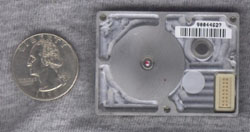The hype concerning Bloom Energy's new solid oxide fuel cells is immense. Former NASA scientist and the companies co-founder, K. R. Sridhar, has worked in secrecy for ten years with the backing of silicon valley's most prominent and successful venture capital firms. The solid oxide fuel cell's thin wafers are made of sand and generate electricity through a electrochemical reaction involving oxygen, natural gas, and a secret lime ink paint. According to one New York Times article, "Bloom executives contend that their device could cut the greenhouse gas emissions from electricity generation by at least 50 percent".
Fuel cell technology has been notoriously difficult to develop and has produced unreliable results in the past. However, the clean energy potential have kept scientist and venture capital firms in the race to produce a fuel cell breakthrough. If the "disruptive technology" of Bloom Energy can create authentic results, the electricity industry could be forever changed. Bloom Boxes could be a fixture in every neighborhood and every office complex. A 1kW system could cost residents as little as $3000.
However, skeptics are in no short supply when it comes to fuel cell technology. So critics believe the best outcome of the Bloom Boxes will be a slight decrease on the load of the coal-burning industry and an increase in use of natural gas. Over the ten-year warranty period, the Boxes will need government subsidies to reach the $0.10 per kWh. The current average U.S. electricity price per kWh is $0.11.
No one can tell at the moment whether Bloom Energy's Boxes will be the miracle energy technology that some predict it to be, or another big flop among venture capital companies. Only time will tell....
Tuesday, March 9, 2010
Tuesday, March 2, 2010
Body Power

An article titled "Move Your Body, Power Your Phone" was published on February 26th in the New York Times. The article outlines the theory of harvesting the movement of the human body, and using that movement to power small electrical devices like our phones or music devices. Piezoelectric crystals printed onto flexible, biocompatible rubberlike material, developed by Michael C. McAlpine of Princeton, produce electricity when flexed and moved.
Theoretically, these devices could first be implanted in shoes, using the power of our steps to run our cellphones. The article goes on to mention the goal of "make[ing] a flexible power generator that could be implanted in the chest". However, the designs for these devices are only in the prototype stages.
But why stop with the human body? Ideas and basic power cell models have been put forth that can use human foot traffic in cities to produce electricity. Piezoelectric crystals embedded in heavily used roadways or pedestrian areas could potentially save money and non-renewable energy sources. With the development of these crystals, anything moving now has the ability to grant us energy. The crystals could be implanted in our bodies, the bodies of our animals, earthquake rich zones, and maybe even the growth or shrinkage of mountains.
Subscribe to:
Comments (Atom)